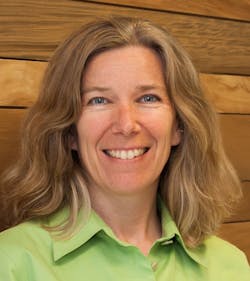USGBC Previews Pivotal COP26 Climate Summit
By JEFF HARDER, U.S. Green Building Council
WASHINGTON, DC, October 20, 2021 — Consider it another hidden consequence of life during COVID-19: Everyone is paying closer attention to the physical spaces in which they live, work and visit.
“Whether it’s being concerned about indoor air quality or just not being able to go certain places during the pandemic, in a way, people are more cognizant of the role of buildings in their lives,” says Elizabeth Beardsley, senior policy counsel for USGBC.
When 197 countries convene from Oct. 31 to Nov. 12 in Glasgow, Scotland, for the 26th United Nations Climate Change Conference of the Parties (COP26), USGBC aims to catch that elevated attention to show the role of buildings in mitigating a warming world.
With an eye toward limiting global warming to 1.5 degrees Celsius, the stated goals of COP26—the latest annual gathering to advance the United Nations Framework Convention on Climate Change — include galvanizing countries to set more ambitious 2030 emissions reduction targets on the way to net zero emissions by 2050, finalizing the Paris Agreement rulebook, tasking developed countries with raising $100 billion toward implementing climate goals, and prioritizing adaptation for communities and ecosystems.
As the green building certification and education standard-bearer, as well as an official NGO observer at the Conference of the Parties for more than a decade, USGBC plans to emphasize the broad, holistic ways in which LEED aligns with those COP26 priorities.
“We’re seeing more attention paid to low-carbon buildings, which is great, and we’re going to keep beating that drum,” says Beardsley, part of USGBC’s COP26 delegation and an attendee for the signing of the Paris Agreement at COP21. “But we’re also saying LEED buildings help protect ecosystems, wildlife, water resources and human health, because those are all integrated into the system.”
Along with developing partnerships, contributing to policy discussions and engaging private enterprises in climate mitigation efforts, the goals of the USGBC delegation include introducing attendees to the rating system updates in LEED v4.1, showcasing LEED Zero and LEED for Cities, as well as the Arc building performance platform and GBCI products and other programs geared toward sustainable sites, zero waste and green financing.
With stakeholders around the world navigating big-picture issues around decarbonization, USGBC provides a gateway to solutions at COP26.
For instance, as policymakers weigh how best to operate power grids using clean energy while rapidly adding capacity to electrify vehicles, heating and cooling, and other components of modern life, LEED v4.1 offers avenues for adaptation, including the GridOptimal compliance path, which helps LEED projects modulate and reduce peak consumption, thereby reducing carbon emissions from peaker plants, and becoming “good grid citizens,” Beardsley says.
As the adoption of green building standards accelerates, USGBC has found that savvy stakeholders have an ever-increasing appetite for details.
“Twenty-five years ago, people wanted to have the simplest way to recognize a green building, and LEED was a symbol people could trust,” Beardsley says. “That’s still the case now, but there’s a whole segment—in government, in the building industry, in the corporate world—that wants to get more into the weeds and understand the data. That’s where LEED v4.1 for Operations and Maintenance (O+M) comes into play, in terms of getting more buildings from new construction into the tracking system right away and having a feedback loop of performance data.”
Beardsley adds that, since LEED v4.1 was crafted to be more usable by the market, she hopes to see more engagement in LEED for O+M and the Arc platform translate into more comprehensive performance data—from greenhouse gases to human experience—to produce a clearer picture of the climate impacts of building operations.
Along with producing presentations and side events in collaboration with the Business Council for Sustainable Energy (BCSE)—a USGBC ally at COP events over the past five years—Beardsley and her colleagues plan to have a presence at the COP26 Cities, Regions, and Built Environment Day on Nov. 11. Throughout the conference, USGBC expects to showcase projects such as the net zero retrofit of the American Geophysical Union’s historic headquarters in Washington, D.C., as well as LEED Zero projects in Brazil, China and other international locales. Additional USGBC programming is under development in the lead-up to the conference.
To put it mildly, COP26 takes place at a moment of urgency as well as possibility. Along with this past summer’s Intergovernmental Panel on Climate Change (IPCC) report revealing a rapidly closing window to limit global temperature rise to 1.5 degrees, climate-related calamities—wildfires, droughts, catastrophic flooding—are taking place from one continent to the next.
Meanwhile, along with the United States’ return to the Paris Agreement and a new administration elevating climate policies and priorities, there’s a sense that significant, meaningful, international action is within reach. The U.S. Congress is debating dual infrastructure bills, with one expected to include significant funding for climate concerns, from clean energy to buildings and vehicles.
“The question,” Beardsley says, “is how do we leverage all of these factors to get us on the right path, so that we can really push over the next 10 years to create a better world?"
##########

